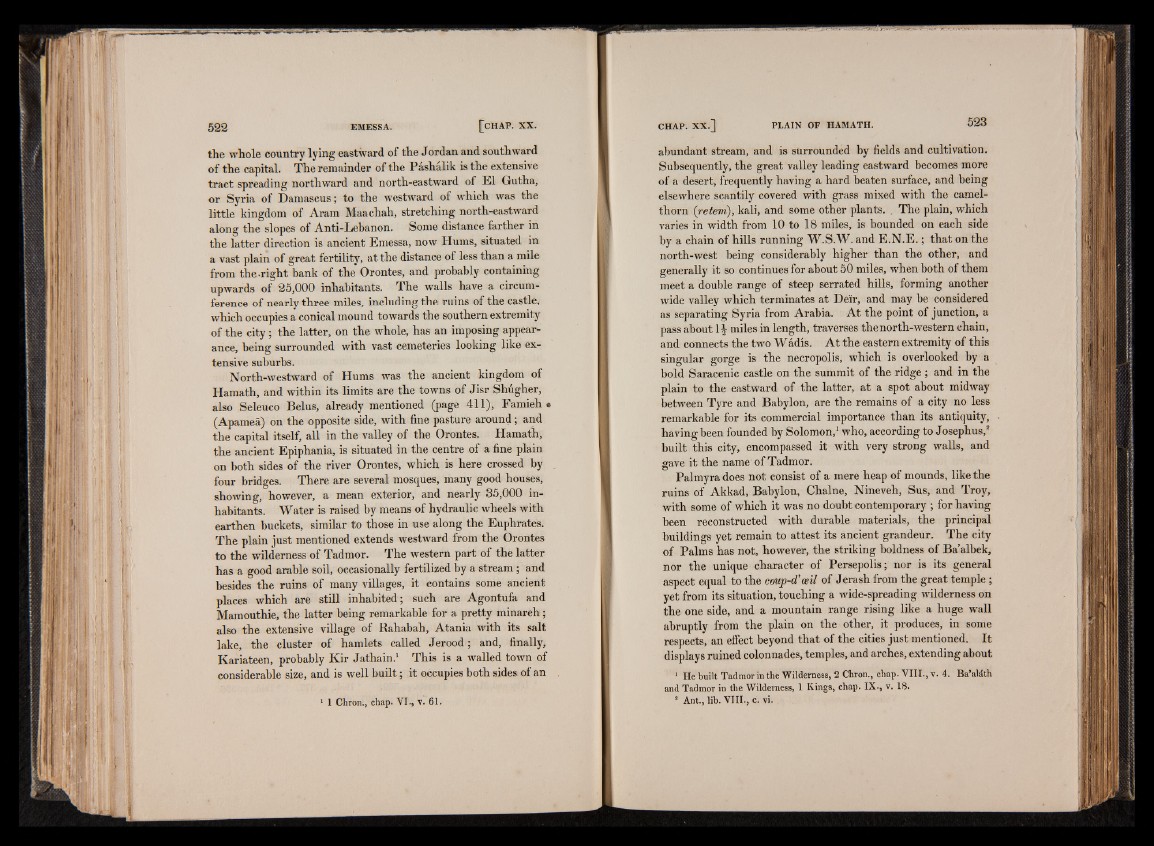
the whole country lying eastward of the Jordan and southward
of the capital. The remainder of the Pashalik is the extensive
tract spreading northward and north-eastward of El Gutha,
or Syria of Damascus; to the westward of which was the
little kingdom of Aram Maachah, stretching north-eastward
along the slopes of Anti-Lebanon. Some distance farther in
the latter direction is ancient Emessa, now Hums, situated in
a vast plain of great fertility, at the distance of less than a mile
from the-right bank of the Orontes, and probably containing
upwards of 25,000 inhabitants. The walls have a circumference
of nearly three miles, including the ruins of the castle,
which occupies a conical mound towards the southern extremity
of the city; the latter, on the whole, has an imposing appearance,
being surrounded with vast cemeteries looking like extensive
suburbs.
North-westward of Hums was the ancient kingdom of
Hamath, and within its limits are the towns of Jisr Shugher,
also Seleuco Belus, already mentioned (page 411), Famieh •
(Apamea) on the opposite side, with fine pasture around; and
the capital itself, all in the valley of the Orontes. Hamath,
the ancient Epiphania, is situated in the centre of a fine plain
on both sides of the river Orontes, which is here crossed by
four bridges. There are several mosques, many good houses,
showing, however, a mean exterior, and nearly 35,000 inhabitants.
Water is raised by means of hydraulic wheels with
earthen buckets, similar to those in use along the Euphrates.
The plain just mentioned extends westward from the Orontes
to the wilderness of Tadmor. The western part of the latter
has a good arable soil, occasionally fertilized by a stream; and
besides the ruins of many villages, it contains some ancient
places which are still inhabited ; such are Agontufa and
Mamouthie, the latter being remarkable for a pretty minareh;
also the extensive village of Rahabah, Atania with its salt
lake, the cluster of hamlets called Jerood; and, finally,
Kariateen, probably Kir Jathain.1 This is a walled town of
considerable size, and is well built; it occupies both sides of an
abundant stream, and is surrounded by fields and cultivation.
Subsequently, the great valley leading eastward becomes more
of a desert, frequently having a hard beaten surface, and being
elsewhere scantily covered with grass mixed with the camel-
thorn (retem), kali, and some other plants. . The plain, which
varies in width from 10 to 18 miles, is bounded on each side
by a chain of hills running W.S.W. and E .N .E .; that on the
north-west being considerably higher than the other, and
generally it so continues for about 50 miles, when both of them
meet a double range of steep serrated hills, forming another
wide valley which terminates at De'ir, and may be considered
as separating Syria from Arabia. At the point of junction, a
pass about 1 | miles in length, traverses the north-western chain,
and connects the two Wadis. At the eastern extremity of this
singular gorge is the necropolis, which is overlooked by a
bold Saracenic castle on the summit of the ridge ; and in the
plain to the eastward of the latter, at a spot about midway
between Tyre and Babylon, are the remains of a city no less
remarkable for its commercial importance than its antiquity,
having been founded by Solomon,1 who, according to Josephus,2
built this city, encompassed it with very strong walls, and
gave it the name of Tadmor.
Palmyra does not consist of a mere heap of mounds, like the
ruins of Akkad, Babylon, Chalne, Nineveh, Sus, and Troy,
with some of which it was no doubt contemporary ; for having
been reconstructed with durable materials, the principal
buildings yet remain to attest its ancient grandeur. The city
of Palms has not, however, the striking boldness of Baalbek,
nor the unique character of Persepolis; nor is its general
aspect equal to the coup-d’veil of Jerash from the great temple;
yet from its situation, touching a wide-spreading wilderness on
the one side, and a mountain range rising like a huge wall
abruptly from the plain on the other, it produces, in some
respects, an effect beyond that of the cities just mentioned. It
displays ruined colonnades, temples, and arches, extending about
1 He built Tadmor in the Wilderness, 2 Chron., chap. VIII., v. 4. Ba’aHth
and Tadmor in the Wilderness, 1 Kings, chap. IX., v. 18.
1 Ant., lih. VIII., c. vi.